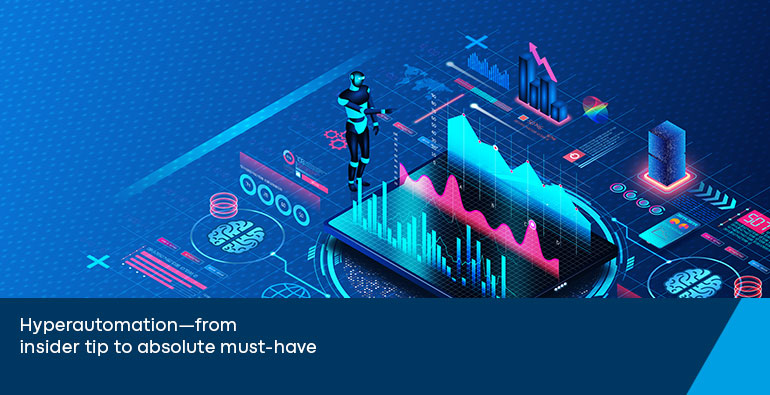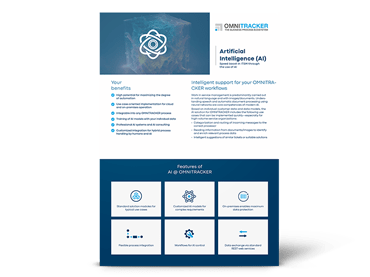Hyperautomation: Why there is no way around this trend

More efficient, faster, more agile: Companies that want to get to the top or stay there must constantly evolve to survive in increasingly complex and dynamic markets. One answer to the “how?” is certainly hyperautomation—a strategic concept that the US market research giant Gartner ranked as one of the nine most important tech trends in 2021.
In this article, you will find out what exactly is behind this topic, how your company can benefit from the advantages of intelligent automation of complex process chains and what you need to consider when choosing the right tools.
What is hyperautomation?
Rather than a single technological solution, hyperautomation is a holistic strategy concept. The idea behind it is very simple: Everything that can be automated in an organization is automated—and optimized in the process. The result: Faster, more precise processes improve performance and thus increase competitiveness. This is achieved with the help of intelligent technologies and automation tools from areas such as machine learning (ML), robotic process automation (RPA), workflow management systems (WMS) and artificial intelligence (AI).
Automation vs. hyperautomation: What’s the difference?
The similar-sounding terms hyperautomation and automation are not synonymous—hyperautomation builds on “normal” automation. While automation is concerned with transforming repetitive individual tasks into automated processes free of manual steps in the course of robotic process automation, for example, hyperautomation goes further. The focus here is on combining various intelligent automation tools as cleverly as possible to uncover, classify and implement automation potential across the board. Automation can therefore be seen as a sub-area of hyperautomation.
The most important sub-areas of hyperautomation
Where individual technological possibilities reach their limits, hyperautomation takes process automation to the next level by intelligently linking them. The most important sub-areas of automation technologies that are smartly linked by hyperautomation include
- Machine learning: ML tools can identify patterns and correlate various findings from the analysis of data—even when a large, unstructured data set is available. For example, free-text documents or language files can also be processed automatically. Because the underlying algorithms are self-learning, they can draw conclusions from the results, make predictions and take complex decisions independently, even beyond if-then cases.
- Robotic process automation: RPA can unfold its potential, especially in repetitive, clearly structured tasks. Software bots perform digital activities that previously had to be carried out manually—such as filtering information from documents, filling out forms or organizing and filing data records—in perfect imitation of the human approach, including logging in and using tools.
- Process Mining: Only those who have an overview of all workflows and processes are able to improve them on the one hand and combine them in an optimized way on the other. Process mining supports this by transparently processing digital workflows and their interrelationships using data traces—and thus laying the foundation for process optimization.
- Intelligent Business Process Management (iBPM)/Workflow Management Systems: iBPM software controls automated sub-processes to create a smooth structure in which automated workflows interlock perfectly. Individual workflows in turn are the responsibility of a workflow management system: It monitors and administers the respective processes and controls procedures, for example, when employees approve decisions or other programs from the RPA need to be consulted.
- Artificial intelligence: AI is a central component of hyperautomation and plays a crucial role. It enables the analysis of large amounts of data, the prediction of future events and the automation of decision-making processes. Through machine learning and intelligent algorithms, artificial intelligence can recognize patterns and correlations in data to make informed decisions and reduce human workloads. The integration of AI into hyperautomation enables companies to optimize processes, increase efficiency and improve the quality of services.
- Business Process Model and Notation (BPMN): BPMN is a standardized graphical notation for the representation of business processes that is used to model, analyze and automate processes. It enables a uniform and visual description of processes, which forms the basis for identifying optimization potential and planning automation measures. Business processes can be automated and optimized more efficiently through integration with automation technologies such as RPA and AI.
This is where hyperautomation comes into play
In the interplay of those sub-processes, hyperautomation achieves an astonishingly high level of performance, which is why many organizations and industries are now relying on this future trend. In addition to the public sector, logistics and life sciences, these include the following industries
- Healthcare: New examination results need to be entered in the patient file or made available to the treating specialist staff, medicines need to be reordered or procured and quotes obtained and prices compared in the process. Staff, from nurses to head physicians, must be assigned, and compliance requirements must be met—healthcare organizations such as hospitals, clinics, or rehabilitation facilities have enormous potential for automation in their recurring processes, which can be efficiently brought together using hyperautomation.
- Insurance: To remain competitive, organizations in the insurance industry need to automate manual processes as comprehensively as possible. There are numerous starting points for this: Intelligent chatbots in customer communication, smart data analysis in underwriting, workflow management for claims processes, or automation solutions for quickly assigning submitted documents and feeding them into the corresponding workflows. This is the only way to continue to meet bureaucratic requirements and keep pace with the competition despite narrower margins. Instead of losing touch with the increasingly digital-savvy clientele, hyperautomation satisfies policyholders with smooth processes in terms of communication and speed.
- Finance: Increasing amounts of data need to be managed in finance. This requires high speed, the lowest possible error rate, and absolutely reliable processes—requirements for which hyperautomation is the solution. This applies to the
- banking sector, for example, to offer a round-the-clock online banking service by using intelligent software to check transactions in the background,
as well as for
-
- financial departments of organizations, for example, when it comes to checking receipts or reading information from PDF invoices—ML tools can generate an astonishing amount of capacity for employees.
- Retail: From automated marketing and the right social media channels to biometric facial recognition of customers at the point of sale—hyperautomation can be used in a variety of ways in retail. For example, AI-supported market analysis enables retailers to flexibly set their prices based on evaluations of the competition and procurement situation. They can also use chatbot systems to communicate with customers and systematically analyze their feedback to optimize the customer experience.
There are also numerous other potential applications for hyperautomation technologies across all sectors. These currently include manufacturing and supply chain management in industrial companies, for example, and are expected to expand into various other business areas in the future. It is only a matter of time before hyperautomation becomes a fixed constant in our daily business—those who adapt to this early on can set themselves apart from the competition.
Find out how artificial intelligence boosts the performance of your service desk in our AI fact sheet.
The 5 most basic benefits of hyperautomation
On the one hand, hyperautomation is a question of budget and know-how. On the other hand, its successful implementation also depends on the management’s ability to plan the roll-out carefully and to get employees on board in good time and with the appropriate sensitivity. Overall, however, the investment pays off in the long term, as both simple and complex business processes are profitably streamlined. The following five decisive advantages of hyperautomation speak in favor of dealing with this future trend promptly and comprehensively:
1. Fast & efficient:
Numerous tasks that were previously performed manually can be completed consistently, precisely, and quickly with the help of hyperautomation. This reduces operating costs and increases competitiveness. In addition, intelligent analysis methods create a sound basis for decision-making and reduce the use of resources in reporting.
2. Smooth process landscape:
Because hyperautomation eliminates or significantly streamlines outdated processes, creating a holistic automation structure, workflows, and processes mesh better overall. This makes it easier to monitor and manage them.
3. Motivated & satisfied:
Hyperautomation allows employees to move away from monotonous repetitive tasks—the free space created is now available for value-adding tasks. This opportunity to focus on creative and challenging activities is motivating and ensures greater well-being at work.
4. Happy customers:
On the customer side, hyperautomation also achieves increased satisfaction through improved communication and an optimized customer experience—customers become more loyal, are more willing to recommend the company to others, and are also willing to accept higher prices.
5. Flexible:
Hyperautomation makes processes easily scalable, which enables companies to become much more agile—a real advantage in dynamic industries where the speed of adaptability is a decisive factor.
What you should definitely consider when introducing hyperautomation
As promising as the introduction of hyperautomation into operational processes can be: You should not embark on this challenging journey head over heels. Before tackling large-scale upheavals under the guise of hyperautomation, it is advisable to approach the topic on a small scale—perhaps as part of a pilot project—and gain experience with the individual sub-areas. The practical knowledge generated in this way serves as a valuable building block for groundbreaking decisions regarding the strategic concept.
Before choosing suitable technological solutions, it is also important to gain an overview of existing processes—process mining tools are already available for this purpose, which is why the leap into the deep end is necessary to a certain extent. If the process landscape is transparent, it is wise to list specific requirements for optimizing these processes. After all, automation must not become an end in itself: Before aiming for a technological solution, workflows should be radically optimized, and unsatisfactory processes should be redesigned if necessary. The data situation should also be explored, and structured and unstructured data should be recorded transparently. This also has an impact on the choice of system solution. Finally, existing tools and systems should be considered, as this is the only way to determine what the desired solution should be able to do and what the need for interfaces is.
Once you have embarked on process automation, it is important to constantly keep the big picture in mind to proceed with automation in a structured manner and create smooth processes.
Newsletter sign-up
Would you like to stay up to date on digital service management, GRC and automation? In our newsletter, we inform you about relevant blog posts and professional articles. We also regularly send you information about events, DACH-wide trade fairs and our free live sessions in the areas of service management, process automation, GRC and analytics with business intelligence. We will inform you about new features of the OMNITRACKER business process platform.

